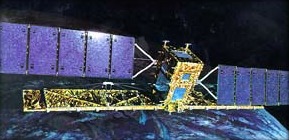![]()

Launched on November 4, 1995, Radarsat has many functions. Radarsat can aid research and resource management in agriculture, oceanography, forestry, hydrology, geology, cartography, meteorology, and many other environmental fields. Since Canada depends so much on its natural resources like forests, mines, and farming, this satellite will be very useful to the country. Although it was expensive to launch, its data will be valuable to many other countries' economies as well. And so, Radarsat's services can be sold for a profit. This is how satellite technology can become a valuable export that helps Canada's economy, instead of a scientific experiment that costs the government money. Radarsat is expected to bring in an estimated $800 million to Canada in return for the data it collects.
Radarsat is in orbit 798 kilometres above the earth, at an angle of inclination of 98.6 degrees to the equator, and it is circling the globe from pole to pole in a sun-synchronous orbit. Because of this, it passes over each area of the globe that it covers at the same time every day. For example, it might make observations of the north pole at noon every day, and of Ottawa at six pm everyday. In a dawn-to-dusk orbit, Radarsat's solar panels will be in sunlight almost constantly so that it can rely mostly on solar power, not battery power.
Radarsat covers the Arctic daily, and most of Canada every 72 hours depending on where the instruments are pointing, and what they are monitoring. It covers the entire Earth every 24 days. Data is downlinked in real time, or stored on the satellite's computer until the spacecraft is within range of a receiving station. The processed data becomes available to people who are hooked up by computer and have paid for Radarsat's services only a few hours after the satellite has passed over an area. This is possible because Radarsat is equipped with an on board computer that can process and transmit information daily to several stations on Earth.
To find out how Radarsat sees so well in the dark, click here.
To find out what Radarsat is used for, click here.